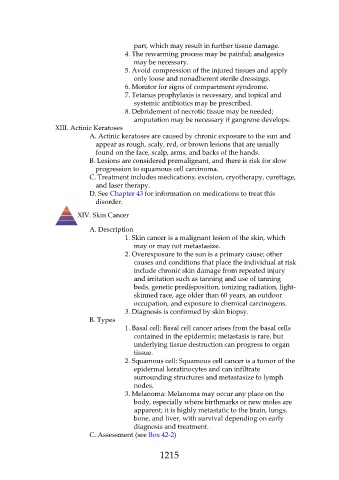Page 1215 - Saunders Comprehensive Review For NCLEX-RN
P. 1215
part, which may result in further tissue damage.
4. The rewarming process may be painful; analgesics
may be necessary.
5. Avoid compression of the injured tissues and apply
only loose and nonadherent sterile dressings.
6. Monitor for signs of compartment syndrome.
7. Tetanus prophylaxis is necessary, and topical and
systemic antibiotics may be prescribed.
8. Debridement of necrotic tissue may be needed;
amputation may be necessary if gangrene develops.
XIII. Actinic Keratoses
A. Actinic keratoses are caused by chronic exposure to the sun and
appear as rough, scaly, red, or brown lesions that are usually
found on the face, scalp, arms, and backs of the hands.
B. Lesions are considered premalignant, and there is risk for slow
progression to squamous cell carcinoma.
C. Treatment includes medications, excision, cryotherapy, curettage,
and laser therapy.
D. See Chapter 43 for information on medications to treat this
disorder.
XIV. Skin Cancer
A. Description
1. Skin cancer is a malignant lesion of the skin, which
may or may not metastasize.
2. Overexposure to the sun is a primary cause; other
causes and conditions that place the individual at risk
include chronic skin damage from repeated injury
and irritation such as tanning and use of tanning
beds, genetic predisposition, ionizing radiation, light-
skinned race, age older than 60 years, an outdoor
occupation, and exposure to chemical carcinogens.
3. Diagnosis is confirmed by skin biopsy.
B. Types
1. Basal cell: Basal cell cancer arises from the basal cells
contained in the epidermis; metastasis is rare, but
underlying tissue destruction can progress to organ
tissue.
2. Squamous cell: Squamous cell cancer is a tumor of the
epidermal keratinocytes and can infiltrate
surrounding structures and metastasize to lymph
nodes.
3. Melanoma: Melanoma may occur any place on the
body, especially where birthmarks or new moles are
apparent; it is highly metastatic to the brain, lungs,
bone, and liver, with survival depending on early
diagnosis and treatment.
C. Assessment (see Box 42-2)
1215

